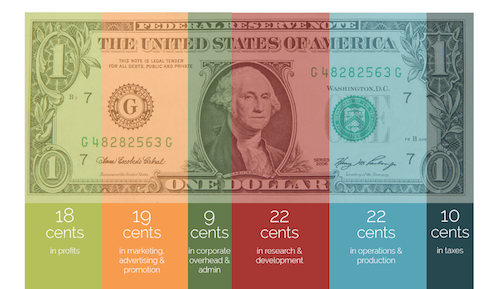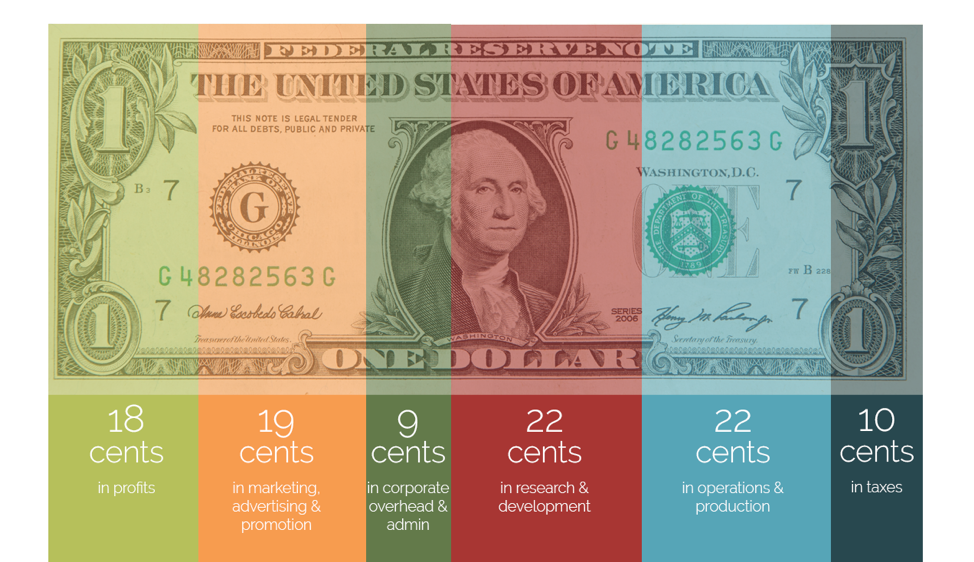© 2025 CSRXP- All Rights Reserved

“Dose of Reality” Breaking Down the Big Pharma Dollar
May 16, 2019
Part II: An Industry Booming Off of Price-Gouging
The average American spends $1,200 per year out-of-pocket on prescription drugs. Altogether, the 10 largest U.S.-based Big Pharma drug manufacturers pulled in a colossal $245 billion in revenue in just one year.
As prescription drug prices continue to climb, causing one in four Americans to not be able to afford their medications, do you ever wonder how Big Pharma spends all those dollars? We set out to get you the answer.
CSRxP, in partnership with GlobalData, conducted a study to determine how Big Pharma allocates revenue across six categories and broke down to the dollar:

Yesterday, we showed how the math undercuts Big Pharma’s favorite go-to excuse: that they need to raise prices in order to fund research and development (R&D). Today we’re looking at Big Pharma’s profits.
How Big Pharma Is Doing
The CSRxP and GlobalData study found 18 cents out of every Big Pharma dollar goes to profits. That means pharmaceutical companies enjoy some of the highest profits of any industry.
Drug makers have the power to unilaterally set list prices and have become very skilled at gaming the system to prevent potential competitors from entering the market.
The result of Big Pharma’s price-gouging and anti-competitive practices is the industry is booming while patients are struggling. In fact, pharmaceutical companies recently reported their earnings for the first three months of this year. 10 of the largest drug makers in the world, including Pfizer, Merck, AbbVie, Bristol-Myers Squibb and Eli Lily, all bested earnings forecasts and raised their outlooks for the year.
The CSRxP/GlobalData study found that 27 cents out of every dollar allocated by Big Pharma goes to profits and corporate overhead – outweighing investment in R&D by five cents.
How They Do It
- Over The Last Five Years, Brand Name Drugs Have Increased In Price At 10 Times The Rate Of Inflation. (HSGAC Report: Drug Prices Rise at 10 Times the Rate of Inflation, The Center for Biosimilars, 4/2/18)
- Even After Drug Companies Said They Would Pause On Price Hikes, More Than 30 Manufacturers Announced They Would Raise Prices In The Beginning Of 2019. (Michael Erman and Robin Respaut, “Big Pharma Returning To U.S. Price Hikes In January After Pause,” Reuters, 12/19/18)
- The Price Of A 10-Milliliter Vial Of Eli Lilly’s Humalog Insulin Cost $21 In 1996, But The Same Vial Now Costs $275. “In 1996, when Eli Lilly debuted its Humalog brand of insulin, the list price of a 10-milliliter vial was $21. The price of the same vial is now $275. Those costs can be compounded by the multiple vials that diabetics may require to survive each month.” (Tiffany Stanley, “Life, Death And Insulin,” The Washington Post, 1/7/19)
- The Pfizer Drugs Receiving Price Hikes Account For Nearly Half Of The Company’s Revenue. “[T]hough Pfizer, for example, increased the list prices for just 10% of its drugs, those drugs account for about half of Pfizer’s revenue.” (Sam Baker, “The Latest Drug Price Hikes,” Axios, 1/25/19)
- A Recent Report Found That Bristol-Myers Squibb Raised Prices On Two Of Its Best-Selling Drugs, Coumadin and Sustiva, 163 Times From 2015 to 2019. (Bob Herman, “Drug Makers Still Raising Prices, But Seeking Fewer Hikes,” Axios, 1/22/19)
Despite mounting pressure to stop the price-gouging bonanza, Big Pharma continues to put profits before patients. Fortunately, there is growing bipartisan momentum in Washington to take action and hold drug makers accountable.
With billions in profits, where is all of this money going? We’ll take a deeper dive into Big Pharma’s spending tomorrow.
CLICK HERE to read: Breaking Down the Big Pharma Dollar Part I: The Math Undercuts the R&D Defense.
###
